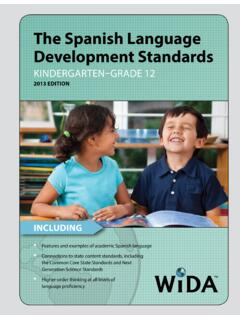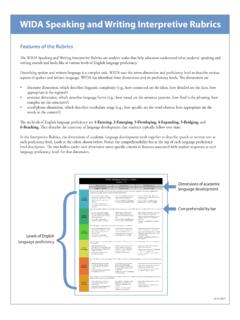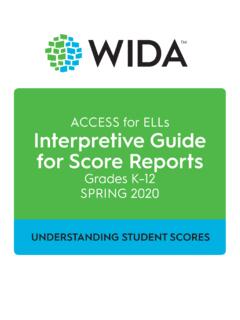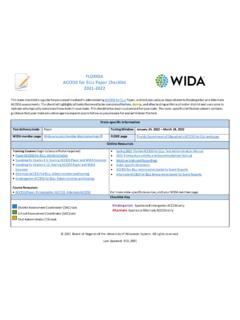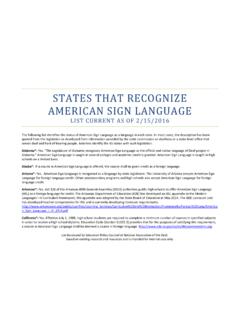Transcription of English Language Profi ciency Standards PreKindergarten ...
1 WORLD-CLASS INSTRUCTIONAL DESIGN AND ASSESSMENTE nglish Language Profi ciency StandardsPreKindergarten through Grade 52007 EditionTHIRD PRINTINGALABAMA, DELAWARE, THE DISTRICT OF COLUMBIA, GEORGIA, HAWAII, ILLINOIS, KENTUCKY, MAINE, mississippi , NEW HAMPSHIRE, NEW JERSEY, NEW MEXICO, NORTH CAROLINA, NORTH DAKOTA, PENNSYLVANIA, OKLAHOMA, RHODE ISLAND, SOUTH DAKOTA, VERMONT, VIRGINIA, WISCONSIN AND WYOMINGC opyright Notice Th e WIDA English Language Profi ciency Standards , 2007 Edition, PreKindergarten through Grade 12 ( WIDA ELP Standards ) are owned by the Board of Regents of the University of Wisconsin System on behalf of the WIDA Consortium.
2 Th e WIDA ELP Standards are protected by United States copyright laws and may not be reproduced, modifi ed, or distributed without the prior written permission of WCER and the Board of Regents of the University of Wisconsin System. Th e WIDA ELP Standards are for your personal, noncommercial use only. You may not alter or remove any trademark, copyright or other notice from copies of this booklet. Fair use of the WIDA ELP Standards includes reproduction for the purpose of teaching (including multiple copies for lesson planning). If you are not sure whether your use of this booklet and the WIDA ELP Standards falls within fair use or if you want permission to use the copyrighted WIDA ELP Standards for purposes other than personal or fair use, please contact the WIDA Consortium intellectual property manager, Jim Lyne, at or (608) 265-2262.
3 2007 Board of Regents of the University of Wisconsin System, on behalf of the WIDA Consortium printing, 2008 Third printing, 2009 iIntroductionAbout the WIDA English Language Profi ciency Standards WIDA s English Language Profi ciency Standards for English Language Learners in Pre-Kindergarten through Grade 12: Frameworks for Formative and Summative Assessment and Instruction, 2007 edition, is a key component of the World-Class Instructional Design and Assessment (WIDA) Consortium s assessment system. WIDA s vision of Language profi ciency encompasses both social and academic contexts tied to schooling, particularly to Standards , curriculum, and instruction.
4 By developing these English Language profi ciency (ELP) Standards , fi rst published in 2004, the WIDA Consortium has responded to this emergent vision to link Language learning with academic content. Furthermore, these ELP Standards guide the development of test blueprints, task specifi cations, and ELP measures, primarily WIDA s ACCESS for ELLs test. Originally developed by consortium members with funding from a Department of Education Enhanced Assessment Grant, the Standards are designed for the many audiences in the fi eld of education who are impacted by English Language learners (ELLs). Th is second edition refl ects an evolving understanding of the needs of ELLs and their educators in the use of the ELP Standards as an instructional and assessment tool.
5 Organization of the StandardsTh ere are fi ve WIDA ELP Standards , which appear in two frameworks: Summative (the outcomes of learning) and Formative (the processes of learning). Th e Standards , identical for both frameworks, refl ect the social and academic dimensions of acquiring a second Language that are expected of ELLs in grade levels PreK-12 attending schools in the United States. Each ELP standard addresses a specifi c context for English Language development. Overall, the Standards center on the Language needed and used by ELLs to succeed in school. Each standard is organized by grade level cluster (PreK-K, grades 1-2, grades 3-5, grades 6-8, and grades 9-12) and by Language domain (listening, speaking, reading, and writing).
6 Within each grade cluster and domain, there are fi ve model performance indicators (MPIs), one for each Language profi ciency level from 1, Entering, to 5, Bridging. All fi ve MPIs focus on the same example topic from a content area refl ected in the standard, forming a strand that illustrates the Language development continuum. Each MPI contains three elements: a Language function ( , describe, justify), an example topic ( , weather, human populations), and a form of support through level 4 ( , pictures or illustrations, working in small groups). Th e components of the ELP Standards , from frameworks down to the elements of an MPI, work together to form the Standards document, a critical tool for educators of ELLs for curriculum development, instruction and assessment.
7 The WIDA English Language Profi ciency Standards English Language Profi ciency Standard 1: English Language learners communicate for Social and Instructional purposes within the school setting. English Language Profi ciency Standard 2: English Language learners communicate information, ideas, and concepts necessary for academic success in the content area of Language arts . English Language Profi ciency Standard 3: English Language learners communicate information, ideas, and concepts necessary for academic success in the content area of Mathematics. English Language Profi ciency Standard 4: English Language learners communicate information, ideas, and concepts necessary for academic success in the content area of Science.
8 English Language Profi ciency Standard 5: English Language learners communicate information, ideas, and concepts necessary for academic success in the content area of Social e ELP Standards are often abbreviated as Social and Instructional Language , the Language of Language arts , the Language of Mathematics, the Language of Science, and the Language of Social Studies. The Language Profi ciency Levels and Performance Defi nitions Th e fi ve Language profi ciency levels outline the progression of Language development implied in the acquisition of English as an additional Language , from 1, Entering the process, to 6, Reaching the attainment of English Language profi ciency .
9 Th e Language profi ciency levels delineate expected performance and describe what ELLs can do within each domain of the Standards . Th e Performance Defi nitions defi ne the expectations of students at each profi ciency level. Th e defi nitions encompass three criteria: linguistic complexity the amount and quality of speech or writing for a given situation; vocabulary usage the specifi city of words or phrases for a given context; and Language control the comprehensibility of the communication based on the amount and types of errors. Th e Performance Defi nitions (see page 3) are a key component of the Standards documents, and the use of the Standards and corresponding MPIs must be in conjunction with the Performance Defi nitions.
10 Th e MPIs, delineated by Language profi ciency level, give expectations for what students should be able to process and produce at a given profi ciency level. Th e Performance Defi nitions describe how well the student can or should be expected to do so. For example, the Language function describe appears in MPIs at levels 1-4. What Language does a student at Language profi ciency level 2 need to produce in order to describe ? What can he or she reasonably be expected to process to understand a description? How does this compare with a student at Language profi ciency level 4? Th e Language function describe for a level 2 student may mean producing or comprehending phrases or short sentences using common adjectives and modifi ers, whereas a level 4 student may be expected to process or use extended discourse incorporating relative clauses, similes or metaphors.

